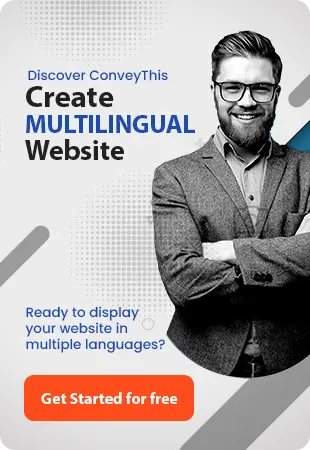如今,許多網站都提供多種語言選項,使來自世界各地的訪客能夠舒適地瀏覽。網路將市場轉變為一種全球體驗,使企業能夠接觸到更廣泛的受眾。但是,如果您的網站僅支援一種語言,則可能會疏遠無法理解您內容的潛在客戶。提供多語言網站可確保用戶可以以其首選語言或母語與您的網站進行交互,從而提高參與度和轉換率。
創建多語言網站不一定很複雜。 ConveyThis 等現代工具使翻譯過程變得無縫,使您能夠在短短幾分鐘內建立一個完全翻譯的網站。本文探討了多語言網站設計技巧,從確保品牌一致到解決文化差異,幫助您設計一個與全球目標受眾產生共鳴的網站。
多語言網站的重要性
對於希望擴大影響力並與不同受眾建立有意義聯繫的企業來說,擁有多語言網站至關重要。讓我們看看為什麼創建多語言網站會改變遊戲規則:
1. 吸引更廣大的受眾
單語網站將您的覆蓋範圍限制為只講該語言的使用者。透過提供翻譯,您可以向更廣泛的受眾開放您的網站,使來自不同地區和文化背景的人們能夠與您的品牌互動。
2. 改善使用者體驗
當使用者可以用他們喜歡的語言瀏覽時,他們會更舒服地瀏覽您的網站。這改善了用戶體驗,增加了在網站上花費的時間,並降低了跳出率。
3. 提升搜尋引擎排名
搜尋引擎優先考慮本地化內容。翻譯您的網站並針對多種語言的搜尋引擎進行優化可以增強您的全球知名度,從而推動來自各個地區的自然流量。
4. 增加信任和轉化
客戶更有可能信任迎合其母語的網站。這種信任轉化為更高的轉換率和更牢固的客戶關係。
單語網站的困難
在當今互聯的世界中經營單語網站面臨許多挑戰。雖然單語言網站可能適用於擁有同質受眾的本地企業,但它極大地限制了旨在吸引國際目標受眾的公司的成長和全球影響力。在這裡,我們探討單語言網站的困難以及為什麼採用多語言網站策略對於成功至關重要。
1.更廣大受眾的可近性有限
單語網站只有了解其所用語言的個人才能訪問。例如:
- 法語訪客可能很難瀏覽純英語網站,即使他們對您的產品或服務感興趣。
- 如果西班牙語用戶找不到他們的首選語言,他們可能會避免與您的內容互動。
這種有限的可訪問性限制了您接觸更廣泛受眾的能力,如果沒有靈活的佈局,就會阻礙您的成長潛力。
2.使用者體驗差
語言障礙會導致無法理解內容的使用者感到沮喪和困惑。糟糕的使用者體驗會導致:
- 當訪客意識到自己無法理解網站時,他們會迅速離開網站,從而導致更高的跳出率。
- 減少對產品描述、表單或支援頁面等關鍵元素的參與。
- 很難瀏覽網站,特別是在結帳等重要流程期間。
以受眾的母語提供內容在地化靈活的佈局對於創造積極且直觀的用戶體驗至關重要。
3. SEO 挑戰
單語言網站錯過了多語言 SEO內容在地化的顯著優勢,包括:
- 在地化關鍵字定位:如果沒有多種語言的內容,您只能針對一種語言的關鍵字進行最佳化,這嚴重限制了您在國際搜尋結果中的可見性。
- Hreflang 實作:缺少 hreflang 標籤意味著搜尋引擎無法正確地將您的內容與特定區域或語言關聯起來,從而降低其相關性。
- 全球排名:單語網站在非本土市場排名較差,這意味著它們無法出現在潛在國際客戶的搜尋結果中。
這些挑戰大大減少了您的網站可能從其他國家吸引的自然流量。
4.轉換率較低
轉換率與使用者瀏覽網站時的舒適度和自信程度有直接關係。單語網站通常會導致:
- 廢棄的購物車:如果客戶不完全理解條款、產品詳細資訊或付款選項,他們就會猶豫是否完成購買。
- 信任問題:使用者可能會認為單語網站包容性較差或專業性較差,尤其是當他們在關鍵互動過程中找不到自己喜歡的語言時。
- 錯失機會:即使您的產品吸引國際受眾,缺乏翻譯也會疏遠潛在買家。
例如,如果產品說明和退貨政策僅提供英文版本,來自德國的購物者可能會離開您的網站。
5.無法迎合多元化市場
單語網站採取一刀切的做法,無法迎合不同地區的偏好和文化差異。考慮以下場景:
- 英文網站可能無法引起日本用戶的共鳴,因為在日本,特定文化的圖像、顏色和術語至關重要。
- 由於語言使用的地區差異,墨西哥的西班牙語使用者可能會感到與西班牙西班牙語使用者的網站脫節。
為了有效地服務全球目標受眾,您的網站必須滿足每個市場的特定需求和期望。
6.客戶支持的挑戰
提供出色的客戶支援對於任何企業都至關重要,但單語網站使國際用戶的過程變得複雜:
- 如果支援資源、常見問題和聯絡表格僅採用一種語言,非母語人士可能很難找到幫助。
- 客戶服務互動中的溝通不良可能會導致不滿意和銷售損失。
多語言網站透過提供多種語言的資源和溝通管道來簡化客戶支援。
7.錯失行銷機會
單語網站限制了您創建個人化和針對特定地區的行銷活動的能力。如果沒有翻譯,您將無法:
- 投放有針對性的廣告:如果沒有在地化內容,就不可能在 Google Ads 或 Facebook 等平台上進行針對特定語言的活動。
- 發送客製化電子郵件:如果國際訂閱者無法理解郵件內容,電子郵件行銷活動就無法與他們建立聯繫。
- 利用影響者:如果其他地區的影響者的受眾無法與您的網站互動,那麼與其他地區的影響者合作的效果就會降低。
拓展國際市場需要在地化行銷工作,而單語網站無法支援這一點。
8.缺乏競爭優勢
在日益全球化的市場中,許多競爭對手已經提供多語言網站。單語網站可能會落後,因為:
- 競爭對手可以更有效地接觸全球受眾並與之互動。
- 多語言網站被認為更具包容性、專業性和以客戶為中心。
未能採用多語言方法將使您的企業處於顯著的劣勢。
9.全球範圍內的難度擴展
隨著企業的發展,他們自然會瞄準拓展國際市場。然而,擴展單語網站存在重大障礙:
- 地區特定問題:單一語言網站無法滿足不同市場的不同需求,例如貨幣換算或地區特定法規。
- 分散的解決方案:為每種語言建立單獨的網站需要大量的時間、精力和資源。
多語言網站為全球成長提供了可擴展的基礎,簡化了擴展過程。
解決方案:擁抱多語言網站
克服單語言網站的困難首先要採用多語言網站策略。透過提供多種語言的內容在地化,您可以:
- 吸引更廣大的受眾並開拓新市場。
- 透過迎合訪客的首選語言來增強使用者體驗。
- 透過優化的多語言 SEO實踐提高搜尋引擎排名。
- 透過解決文化和語言偏好來建立信任並提高轉換率。
ConveyThis 等工具可實現翻譯流程無縫銜接,幫助您建立專業、可擴展且使用者友好的多語言網站。從自動偵測語言到靈活的設計調整,ConveyThis 可確保您的網站吸引不同的目標受眾,而不會影響其可用性或品牌形象。
有效的多語言網站設計技巧
創建多語言網站不僅僅是簡單的網站翻譯。設計必須適應不同的語言、文化偏好和使用者期望。有效整合在地化的可擴展網站可以提高受眾參與度並確保跨地區的無縫瀏覽體驗。以下是設計支援多種語言和不同使用者需求的靈活佈局的一些實用技巧。
1. 跨語言的一致品牌
無論使用者造訪哪種語言版本,使用者體驗都需要保持一致。即使進行了必要的本地化調整,外觀和感覺也應保持統一。在不同語言之間切換的訪客絕對不應該感覺自己登陸了一個完全不同的網站。
靈活佈局和品牌風格等設計元素在所有語言中都應該是統一的。 ConveyThis 等工具可準確識別文字並無縫處理網站翻譯,從而簡化了此過程,即使在使用其他外掛程式時也是如此。
一致的全域設計模板不僅可以節省添加新語言的時間,而且還支援可擴展的網站基礎架構。例如,Airbnb 跨語言保持相同的主題和功能,創造了完美、有凝聚力的使用者體驗。
這是日文版本:
毫無疑問,這是同一個網站。背景是一樣的,搜尋功能也是一樣的。統一的設計有助於您的品牌形象,並在添加新語言或更新時節省時間和精力。
2. 清晰易用的語言切換器
在每個頁面的可見位置顯著顯示語言切換器,確保所有使用者都可以存取。易於找到的選項可提高受眾參與度,因為訪客無需搜尋隱藏功能即可切換語言。
為了更好的本地化,請以其本機形式顯示語言名稱(例如,“Español”而不是“Spanish”)。這種方法創造了一種包容性的體驗,並確保您的網站翻譯工作感覺真實。 Asana 的語言選擇下拉式選單是直覺設計如何提高可用性的一個很好的例子。
3.“語言”優於“地區”
許多國際大品牌會讓您切換區域,以便能夠以您的語言閱讀網站。這是一個糟糕的想法,它會讓訪客更難瀏覽。這些網站的工作假設您正在使用該語言的區域進行瀏覽,因此您可以獲得您的語言的文本,但您可能無法獲得您感興趣的區域的內容。
下圖取自Adobe網站:
語言不應該與其地域密不可分。以紐約、倫敦和巴黎等國際大都市為例。也許居住在英國的比利時人想從英國網站購買但用法語瀏覽。他們必須選擇是從比利時網站上用他們的語言購買還是從英國網站上用英語購買,但他們兩者都不想做。這樣你就無意中製造了一個障礙。我們來看一個可以單獨指定語言和地區的網站,Uber 網站。
這是出色的設計。在這種情況下,語言切換選項已放置在左側的頁腳中,由於選項眾多,您有一個模式,而不是下拉框。語言名稱也用自己的語言來引用。
作為獎勵,您可以「記住」用戶選擇的語言,這樣從第一次訪問開始,他們就不必再切換了。
4. 自動偵測位置
此功能非常有用,因此您的訪客不會透過錯誤的語言進行存取。並節省使用者的時間,這樣他們就不必尋找語言切換器。它的工作原理是這樣的:網站識別瀏覽器使用的語言或其位置。
但要小心,如果使用者是遊客並且不熟悉當地語言,因為他們需要語言按鈕才能切換,因此,該工具並不總是準確的。
設計多語言網站時,不要在自動偵測語言和語言切換器之間進行選擇,後者是強制性的,而前者是可選的。
5. 標誌不適合替代語言名稱
有21個西班牙語國家和18個英語國家,而中國有8種主要方言,因此國旗並不能很好地取代語言名稱。此外,標誌可能不是有用的指示符,因為它們可能會讓那些不認識它們的人感到困惑。
6. 靈活調整文字空間
這可能是一個挑戰,但不可否認的是,翻譯並沒有佔據與原文相同的空間,有些可能更短,有些可能更長,有些甚至可能需要更多的垂直空間!
漢字包含大量訊息,因此不需要太多空間,而義大利語和希臘語則更加冗長,需要兩倍的行數。一個好的經驗法則是假設某些翻譯可能需要超過 30% 的額外空間,因此要靈活佈局並為文字分配足夠的空間。原始網站中的那些狹窄空間可能根本沒有足夠的空間進行翻譯,英語是一種特別緊湊的語言,如果您發現需要用英語縮寫以使內容適合,那麼您在翻譯時肯定會遇到一些麻煩。
除了為文字提供伸展空間之外,擁有自適應 UI 元素也是一個好主意,這樣按鈕和輸入欄位也可以增大,您也可以減小字體大小,但不要太多。
Flickr網站是多語言的,我們來看看原來的「views」按鈕:
它看起來棒極了,一切都很棒,但「視圖」在其他語言中卻是一個更長的詞,需要更多的空間。
在義大利語中,它需要三倍的空間!
許多非拉丁文字(例如阿拉伯文字)需要更高的高度才能適合翻譯。總而言之,您的網站佈局應該足夠靈活,以適應不同的語言要求,以便在切換時不會丟失原始的精美外觀。
7. 網頁字體相容性與網站編碼
根據 W3C,強烈建議您使用 UTF-8 對網頁進行編碼,以便使用特殊字元。
很簡單,UTF 聲明看起來像這樣
還要確保字體與不同語言相容,否則文字可能最終看起來難以辨認。基本上,在決定任何字體之前,請檢查其與您需要的所有腳本的兼容性。如果您想進入俄羅斯市場,請檢查是否支持西里爾字母。
下圖取自 Google Fonts,如您所見,您可以選擇下載您需要的任何腳本版本。那些字元數量較多的語言會產生較大的字體文件,因此在選擇和混合字體時請考慮這一點。
關於從右到左的語言
隨著中東市場的成長,您可以考慮創建一個吸引該地區訪客的網站版本,這意味著要調整佈局,使其與他們的語言相容。大多數中東語言的一個特點是它們是從右向左閱讀的!這是一個巨大的挑戰,解決方案從鏡像介面開始。
這是 Facebook 針對從左到右的語言(例如英語)的設計。
這是從右到左語言的翻轉設計,例如阿拉伯語。
仔細觀察,設計中所有內容的位置都已鏡像。
請參閱 Robert Dodis 關於從右到左語言設計的文章以獲取有關如何執行此操作的更多資訊。
一些從右到左的語言包括阿拉伯語、希伯來語、波斯語和烏爾都語,ConveyThis 可以輕鬆調整您的網站以滿足他們的語言要求並確保良好的用戶體驗。最好的事情是您可以自訂每種語言的外觀並更改字體類型或其大小,如有必要,還可以編輯行高。
8.選擇合適的圖示和圖像
視覺效果具有非常濃厚的文化成分,是正確網站設計的關鍵要素。每種文化賦予不同的圖像和圖標不同的意義,有些解釋是正面的,有些則完全相反。有些圖像反映了一種文化的理想體驗,但在不同的背景下,它會讓使用者感到疏遠。
這是一個因不符合文化而必須更換的圖像範例。請注意,並非所有圖像都會冒犯他人,當您希望人們對您的產品感到好奇和感興趣時,它可能只會產生冷漠。
這是嬌韻詩的法語主頁,以一位白人女性為特色。這是韓國版本,一位韓國女性擔任該品牌的大使。
可能令人冒犯的視覺效果對某些文化似乎是無辜的,但在不同文化的眼中,它們展示的是非法或禁忌的行為,例如對同性戀或女性賦權的描述。
這也適用於偶像,而在美國,兩個香檳杯敬酒的偶像代表慶祝,而在沙烏地阿拉伯,飲酒是違法的,因此必須用文化上合適的偶像來取代該偶像。
因此,需要進行研究以確保您選擇的圖標適合目標市場。如果您不確定,您可以始終謹慎行事。
例如,這三個以地球為主題的圖標,第一個是為澳洲觀眾設計的;第二個是針對非洲觀眾的;最後一個適合更多的全球觀眾,因為沒有特定的區域。
最後但並非最不重要的一點是,ConveyThis 可以翻譯任何文本,只要它未嵌入圖像中即可。該軟體將無法識別上面寫的內容,因此它將保留原始語言,因此請避免嵌入文字。
9. 顏色的選擇
如上一節所提到的,不同文化對圖像的解釋不同,顏色也有同樣的情況。它們的意義是主觀的。
例如,在某些文化中,白色是純真的顏色,但其他人可能不同意,它是死亡的顏色。紅色也是如此,在亞洲文化中,它用於慶祝活動,但對於一些非洲國家來說,它沒有如此積極的含義,因為它與暴力有關。
然而,藍色似乎是所有顏色中最安全的,通常與平靜與和平等積極意義聯繫在一起。許多銀行在標誌中使用藍色,因為它也意味著信任和安全。
本文展示了世界各地顏色含義的差異,對於您開始研究什麼顏色最適合您的多語言網站非常有用。
10. 格式調整
請考慮在書寫日期時避免僅使用數字,因為書寫日期的方式有很多種,在美國,官方格式是mm/dd/yyyy,如果您只能看到數字,則某些來自使用不同系統的其他國家/地區的使用者(例如dd/mm/yyyy)可能會感到困惑。因此,您的選擇是:確保翻譯版本採用了日期格式,或用字母寫出月份,以便 ConveyThis 始終寫出正確的日期。
此外,雖然美國使用英制,但大多數國家/地區使用公制,因此您需要確定您的網站是否適合轉換測量值。
WordPress 最佳翻譯插件
在向 WordPress 網站添加翻譯外掛程式時,有許多選項,但並非所有選項都以相同的方式運作,結果會有所不同。使用ConveyThis,無論您的網站設計如何,都可以保證完美整合。
ConveyThis 是網站翻譯的最佳選擇,提供 92 種語言。這是一個可靠的 WordPress 插件,可讓您快速擁有可靠的多語言版本的網站。它可以理解網站的佈局,檢測所有文字並進行翻譯。 ConveyThis 還包括一個用於文字自訂的直覺編輯器。
ConveyThis 包含一個通用的語言切換按鈕,預設適用於任何網站,但您也可以根據需要進行編輯。我們也遵循本文所述的設計原則:
- 網站所有語言版本上的品牌保持一致。
- 清晰的語言切換器和選擇首選語言的選項。
- 網站自動使用 UTF-8 編碼。
- 從右到左語言的正確接口
ConveyThis:值得信賴的多語言網站解決方案
創建多語言網站並不一定很複雜。使用ConveyThis,翻譯過程是無縫、快速且適合初學者的。這個強大的工具可讓您將網站翻譯成多種語言,而不會破壞其設計或功能。
ConveyThis 的主要優點:
- 快速設定:安裝插件,選擇您的語言,然後在幾分鐘內開始使用。
- 自動翻譯:偵測並翻譯所有內容,包括產品描述、表單和應用程式產生的文本,同時保持格式。
- 可自訂的翻譯:使用視覺化編輯器來完善翻譯並使其適應您的目標受眾。
- 專業服務:聘請語言專家提供精確且與文化相關的翻譯。
- SEO 優化:包括 hreflang 標籤、在地化 URL 和元資料翻譯,以提高全球搜尋引擎排名。
- 可擴展以促進成長:隨著您的業務擴展,輕鬆添加語言並管理翻譯。
無論您是首次建立多語言網站,還是擴展到新市場,ConveyThis 都能確保平穩過渡,增強用戶體驗,並提高全球知名度抵達。憑藉 14 天免費試用期,現在正是讓您的網站實現多語言化的最佳時機!
其他資源:
- ConveyThis 整合 探索與 WordPress 的兼容性。
- 如何翻譯 WordPress 以獲取更多指導。
- 翻譯 WordPress 網站的幫助指南以獲得逐步支援。
翻譯不僅僅是了解語言,它是一個複雜的過程。
透過遵循我們的提示並使用 ConveyThis ,您的翻譯頁面將引起受眾的共鳴,感覺是目標語言的母語。
雖然需要付出努力,但結果是有益的。如果您要翻譯網站,ConveyThis 可以透過自動機器翻譯節省您的時間。
免費試用ConveyThis 3 天!
 沒有銀行卡詳細信息
沒有銀行卡詳細信息



